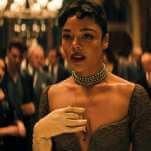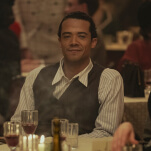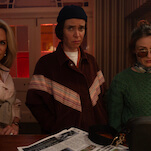Welcome to The A.V. Club’s coverage of Orange Is The New Black season five. These reviews and their comment sections are intended for those who have seen up to this episode—please refrain from revealing or discussing events from future episodes in the comments.
The fourth season of Orange Is The New Black ended on a textbook cliffhanger, with Daya pointing a gun at Humphrey’s head while the rest of her fellow inmates cheered her on.
This was not Orange Is The New Black’s first cliffhanger: the first season ended with Piper pummeling Pennsatucky, without a clear sense of how it would impact her future in the prison. And these are certainly not Jenji Kohan’s first cliffhangers, as nearly every season of Weeds ended on a potentially show-changing moment: people were held at gunpoint, people were murdered with croquet mallets, and people were shot by a sniper, all in the interest of fostering uncertainty among the viewing public.
The problem with cliffhangers, though, is resolving them. When you build a season to a cliffhanger that places the entire show in jeopardy, you then have to find a way to bring the show back down to earth, and into a sustainable pattern for the remainder of the season. If a TV show leaves you hanging on a cliff, the first thing it has to do is pull you to safety at the top of that cliff to resolve the immediate tension; after that, though, it also needs you to get resettled so that you can start climbing up the next cliff toward the next finale, and potentially the next cliffhanger.
However, the fifth season of Orange Is The New Black is not a typical TV season. While most cliffhangers need to be resolved in ways that allow the show to return back to a stable structure in the next couple of episodes, “Riot FOMO” is the start of a season that will take place entirely within the cliffhanger. The entire season will take place within the riot that was beginning to unfold in the final moments of season four, meaning that there is no escape: we are trapped on that cliff until the end of the season, and we’re just going to have to live with that.
At least through one episode, the decision strikes me as better in concept than practice. “Riot FOMO” is not a bad episode by any means, but there is something fundamentally disorienting about its attempts to match the show’s balance of comedy and drama in the immediate aftermath of such a tragic series of events. The episodes leading up to Daya holding that gun were driven by intense emotions of anger, frustration, and injustice, and certainly that translates here in particular storylines. However, other storylines play the situation as a comedy, which fits with the show’s “dramedy” aesthetic but seems diminishing in this case given the weight of what motivated the cliffhanger to begin with.
The structure of the episode is a sort of chaotic simplicity: rather than making some type of left turn, it delivers exactly the chaos that the cliffhanger promised. Daya shoots Humphrey in the leg, after some back-and-forth, and then the inmates split up and instinctively go into “riot mode.” Their choices speak to both their innate characteristics as well as their current situations. Alex and Piper, wary of being caught for the murder of the guard last season, steer clear entirely; others see an opportunity to reclaim confiscated personal items (Red), raid the kitchen (Frieda), or occupy the commissary (Boo and Pennsatucky). The Latina inmates take control of the riot itself, rounding up guards with the help of Daya and her gun, while the Black inmates seek justice for Poussey and storm Caputo’s office. Morello and Nicky, meanwhile, think big picture and head to the pharmacy, fighting off the methheads in order to become “big pharma” in the days to follow.
On a macro-level, these stories create a large collection of branching off points, and a sense of the prison ecosystem that will develop over the course of the season. On a micro-level, though, it is awkward to jump between stories where the emotional weight of this story is real and ones where characters like Maritza and Flaca are acting like it’s just another day at the riot factory. The strongest story in this episode is the black inmates’ takeover of Caputo’s office, as it balances drama and comedy effectively: there are jokes in these scenes, but at its core is the inmates’ desire for Caputo to do right by Poussey in a way his news broadcast didn’t. It’s funny when Cindy knees Josh from PR in the nuts, and it’s enjoyable for Taystee to punch Caputo in the face, but they are motivated by anger and grief, not just chaos itself. Caputo is also himself a conflicted figure, understanding that he did wrong by Poussey but unwilling to call Bayley a murderer with a good conscience. There is a balance in these scenes, with jokes emerging from their banter but their central actions determined by a very clear and emotionally resonant set of motivations.
The same cannot be said for the Latina inmates, as the show struggles under the weight of an effectively random decision to have Daya be the one to pick up the gun. As I noted last season, the logic behind Daya picking up that gun is left unstated: while there are arguments to be made about her history with Bennett and her frustration over her family situation, very little of that made it on screen, meaning it reads as the show deciding it should be her based on its future potential, rather than any narrative buildup. As a result, though, I struggled to find Daya’s breakdown to be a meaningful emotional counterpoint to Maritza and Flaca bantering about how fun it is to riot, given there was no clarity in terms of what had brought her to this point. The episode has slightly more success with Gloria’s desperate efforts to enlist Sophia to help save Humphrey in order to protect Daya, but this storyline remains inert for me, and feels disconnected from the emotional buildup that made the cliffhanger itself as well as Taystee’s crusade here so resonant.
Within each individual story, there are clear efforts to balance real stakes with comic banter. Nicky and Morello’s story involves lots of methhead idiocy, but it’s also reinforcing Nicky’s addiction and Morello’s concern that the riot could lead her to relapse; Piper and Alex’s adoption of Linda from Purchasing (who got swept up in the riot) is a fundamentally comic situation, but it’s inflected by the dead body in the garden, and Piper’s pending release in three months; Boo and Pennsatucky spend most of their time doling out supplies and offering theories about proper snacking, but Coates stops by to share “a moment” with Pennsatucky to remind us of her inability to quit their abusive relationship. This balance of drama and comedy is a hallmark of the show, but it feels odd in a situation where everyone is in the midst of an actual crisis, which puts all of their lives at risk. Although the season’s premise will mean that the stakes are high at every moment, not all of the characters see that, which is realistic but creates some cognitive dissonance personally as a viewer whose primary interest is in the consequences rather than opportunities of what transpired to begin the episode.
As the first hour of what may turn out to be a thirteen hour bottle episode, “Riot FOMO” carries a burden of establishing a sense of order to the chaos: characters claim territory, outline their strategies, and collect together in story pods—like Judy King stumbling onto a grieving Soso in the library—that can play out in the episodes that follow. That work is mostly successful, and I remain excited by the prospect of “living on the edge” of the cliffhanger (if we embrace the metaphor). And I fully expected that the show would not completely embrace the dramatic consequences of said cliffhanger and shift away from comedy, given how committed Jenji Kohan is to using genre play as a way to both create and resolve tension in her storytelling. But I couldn’t help but feel this episode needed to skew more dramatic to successfully connect with the raw emotion that drove characters to riot last season, and left wishing that we could have spent more time with the characters who rioted for a reason and less time with the characters who are rioting because it’s a way to kill some time.
Stray observations
- Anyone who knows me knows how I feel about verisimilitude, so if someone wants to explain to me how Piscatella received a random push notification on his phone about the Litchfield video, I’m all ears: the idea of that “going viral” this way from Josh from PR’s Twitter account is an insane fiction, but I get they needed to speed up parts of the story if they wanted to get through as much as possible during the short span of the season.
- Did anyone else spend the episode trying to figure out the geography of Litchfield, and how so many people seemed unaware of the riot happening around them? The weirdest for me was the guy in the medical wing, who acts almost nonchalant about the guard with the gunshot wound that Sophia brings in. (I was also distracted by the fact he’s played by Gerrard Lobo, who played Anush on Master of None).
- Humphrey might not die, but the episode doesn’t buy his attempt to humanize himself, immediately exposing his limp dick (he went commando) and then slotting him into the hospital between Suzanne and Maureen (who, you’ll remember, he forced to fight one another). His torture is not over.
- Note that Alex and Piper were having their conversation about the dead guard while Linda from Purchasing was in the stall next to them—it’s unclear if she was listening (she acts pretty dumb in this episode), but it’s something to put a pin in for the future.
- I appreciated the Josh from PR’s quick realization that the inmates’ video actually helps MCC, which turns him into a willing accomplice. He’s also 100% right about Snapchat being a closed system and thus useless for their strategy, that’s some strong social media management there.
- I realize that the massive incompetence of the remaining C.O.s is part of the point, but I’ve got questions about how they’ll integrate into this story, with a small group held hostage and another group holed up in the kitchen. They’re wild cards in this scenario.
- That said, I appreciated how quick Luschek becomes a co-conspirator: he obviously doesn’t care about his job or about Litchfield, so he’s a different type of free agent, despite also technically being a hostage at this stage.
- Piper is ultimately a very minor figure in this episode, but we get some peak privilege from her as she expresses her FOMO from missing both the lake and the riot. Poor Piper!
- The episode ends on another cliffhanger, as we’re unsure who has kept Daya from calling to the outside: were they trying to stop her from reaching her mother? Were they just trying to get her gun? It’s a cliffhanger within a cliffhanger, and propels us into the next episode with a new set of uncertainties.
Notes on Binge-Reading
Hey, everyone—thanks for joining me for another season of OITNB reviews. There is no shortage of online coverage of the show, so I very much appreciate you coming along on another journey.
These reviews have had two different forms over the years: they began as two episodes per week, but eventually evolved to an episode a day, which was too fast for some and still too slow for others. While I worked hard to try to retain a comment culture by policing spoilers and trying to make each day’s conversation as lively as possible, there was really no “perfect” solution to the realities of Netflix’s binge structure.
And so, we are experimenting this year, and all thirteen reviews will be posting over the course of today (June 9) roughly in line with where a reckless person who stays up all night—or someone in an overseas territory where the release time is more reasonable—would have watched the show. It is a decision we came to as a result of both Netflix making the entire season available in advance and specific narrative qualities of the season that make it blend together even more than your average season of OITNB or Netflix series in general. It is also a decision I did not make lightly, given that it will make continuing the comment culture I voluntarily committed myself to very difficult.
So here’s what I’m going to suggest we do:
- First, I am still going to make warnings about spoilers, indicating that each review and its comment section are intended for people who have seen only up to the episode in question. I will do my best to sweep through the comments searching for spoilers, although as always there are no promises in this area, so please do your part and avoid directly discussing, alluding to, or reacting to future episodes lest it head in that direction.
- Second, I am going to personally focus my energy on participating in the discussion for episodes on a daily schedule, beginning with this episode today, the second episode tomorrow, etc. We will be promoting the episodes to our social feeds on this schedule, and so I’m hoping those who were previously commenting on a daily basis will continue to do so along with me, in order to retain the community function that’s so valuable.
This is now four years since we started having to tackle the best way to cover Netflix shows, and I really do think this season is the right one to start this experiment, but I’m hopeful we can still all come together each day to watch how even in a season spanning only three episodes there is STILL HOPE that our favorite Litchfield inmates make it to Mars this season.








































